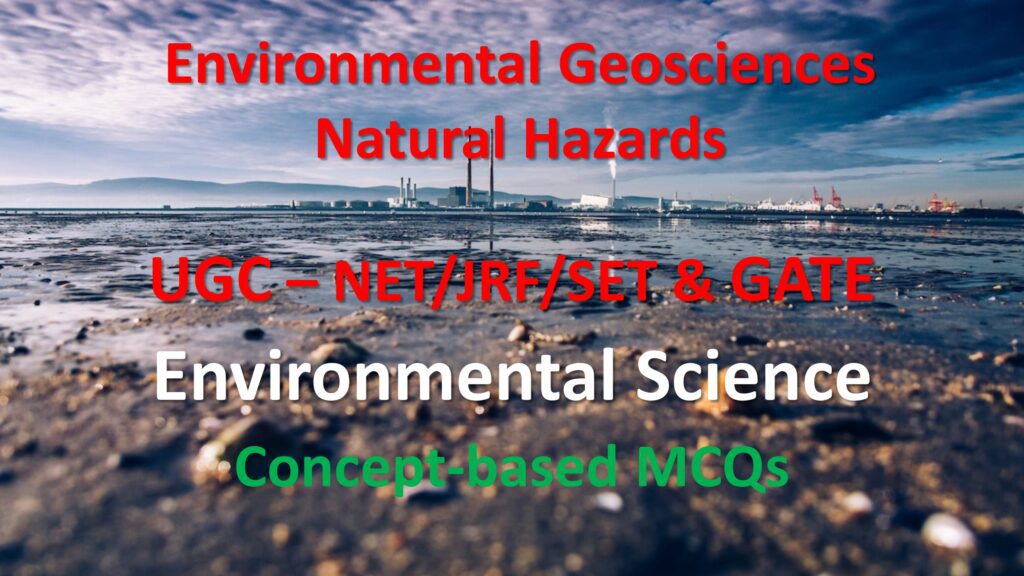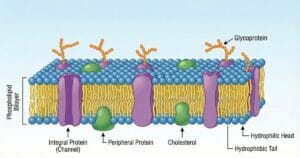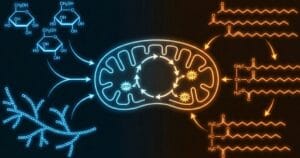
COMPETITIVE EXAM MCQs SERIES of ENVIRONMENTAL SCIENCE for UGC-NET/JRF, SLET, GATE, and other entrance tests – Environmental Geosciences – Natural Hazards.
Syllabus outline
- Definition and classification of natural hazards (e.g. earthquakes, volcanoes, landslides, floods, hurricanes, tsunamis).
- Historical examples and impacts of major natural disasters.
- Tectonic plate movements and faulting processes.
- Seismic waves, magnitude, and intensity scales.
- Earthquake monitoring and early warning systems.
- Volcanic processes and types of eruptions.
- Volcanic hazards (e.g. lava flows, pyroclastic flows, ashfall, and volcanic gases).
- Volcano monitoring and risk assessment.
- Types of landslides and their triggers (e.g. heavy rainfall, seismic activity).
- Landslide risk assessment and mitigation strategies.
- Causes of floods and flood forecasting.
- Floodplain mapping and flood risk management.
- Formation and characteristics of tropical cyclones and hurricanes.
- Storm surge, wind damage, and coastal impacts.
- Causes of tsunamis and their propagation.
- Coastal hazard assessment and early warning systems.
- Study of climate-related hazards, such as droughts, heatwaves, and extreme weather events.
- Impact of climate change on natural hazards.
- Techniques for assessing the vulnerability and risk of natural hazards.
- Strategies for mitigating the impacts of natural disasters.
This quiz contains the concept-based most frequently asked 25 MCQs of “Environmental Geosciences – Natural Hazards“. Each question has a single correct/most appropriate answer.
*****
1. Which is not an ideal solution for tackling water shortages?
a) Controlling water pollution
b) Controlling population growth
c) Conserving water in irrigation
d) Drilling a large number of deep bore wells
2. Which is an example of a climatological disaster?
a) Landslide
b) Tsunami
c) Drought
d) Earthquake
3. Among which of the following Hazards and Disasters are classified?
a) Chemical and physical
b) Natural and Man-made
c) Natural and Man-made
d) Cultural and Social
4. Which of the following is NOT always a natural disaster?
a) Volcano
b) Earthquake
c) Tropical cyclones
d) Floods
5. Mock drills are an important part of disaster mitigation because:
a) They are an integral part of corporate social responsibility (CSR)
b) They are mandatory requirements of the environment management system of an organization.
c) They help improve response preparedness and identify the scopes of improvement in the disaster management plan
d) Pollution control boards mandate it, and industries are obligated to comply
6. Which flood is characterised by unplanned development and improper solid waste management practices?
a) Arial/Meteorological
b) Flash
c) Urban
d) Coastal
7. Which of the following can reduce evaporation and increase infiltration?
a) Contour trenches
b) Crop Rotation and intercropping
c) Siltation
d) Mulching
8. What is the first step towards planning an efficient disaster mitigation plan?
a) Risk Assessment
b) Emergency Response
c) Hazard Identification
d) Rescue and Relief operations
9. Volcanoes are generally found where
a) Tectonic plates pull apart or are coming together
b) Island pull apart or are coming together
c) Earth’s crust pulls apart or are coming together
d) Intraplate pull apart or are coming together
10. Which condition is not directly linked with drought conditions?
a) Not having adequate soil cover
b) Not having enough topsoil and a hardpan
c) Slow runoff and increased infiltration into the soil
d) Less rainfall than normal and poor distribution of rainfall
11. Which is not an example of a rapid-onset disaster?
a) Cyclone
b) Drought
c) Earthquake
d) Tsunami
12. The expected losses due to any unexpected event can be termed as:
a) Vulnerability
b) Accident
c) Risk
d) Disaster
13. IWRM addresses the “three E’s”:
a) Ecosystem Management, Environmental Impact and Social Equity
b) Evaluation of Resources, Economic efficiency, Environmental sustainability
c) Economic efficiency, Environmental impact assessment and Social Equity
d) Economic efficiency, Environmental Sustainability and Social Equity
14. Which is not necessarily a mandatory requirement for forest fires?
a) Source of ignition
b) Fuel
c) Air (oxygen)
d) Human interference
15. Which of the following natural resources is productive?
a) Uranium
b) Fossil Fuel
c) Soil
d) Coal
16. If wind speed is increased by double then energy will increase by about
a) 414x
b) 4x
c) 2x
d) 8x
17. In which direction did tropical cyclones blow in the northern hemisphere?
a) Clockwise direction
b) Anticlockwise direction
c) Straight forward
d) In any direction
18. To increase the rotational speed a low-speed shaft needs to be connected with a high-speed shaft with the help of:
a) Generator
b) Gear box
c) Nacelle
d) Powered rotor
19. Which rainwater harvesting method can be adopted by individual house owners?
a) Creation of new water bodies
b) Construction of recharge trenches
c) On-channel storage of water
d) Roof-top rainwater harvesting
20. The tropical cyclones are not likely to occur near the equator because of negligible:
a) Coriolis force
b) Depression force
c) Centripetal force
d) Centrifugal force
21. Tropical cyclones spin in different directions based on their:
a) Both Velocity and Energy
b) Velocity
c) Energy
d) Location (northern/southern)
22. Which of the following statements is false about sustainable forest management?
a) Most of the northern countries have large capacities in terms of financial and human resources to manage forests.
b) Most southern countries have socio-economical equity with low financial and human resources to manage forests.
c) Forests of northern countries are less complex, often smaller, fragmented and have lower biodiversity.
d) Forests of southern countries are extended and complex forests with high biodiversity.
23. Which of the following is correct about Coriolis force?
a) If it were not for the Earth’s rotation, global winds would blow in straight north-south lines
b) Coriolis force affects only the large-scale movement of air in the atmosphere
c) Coriolis effect is caused by the rotation of the Earth and the pressure difference between 2 points
d) Winds are deflected to the right in the Southern hemisphere
24. Which disaster is because of an earthquake beneath the oceanic crust?
a) Tsunami
b) Drought
c) Forest fire
d) Cyclone
25. The point on the earth’s surface above the hypocentre of the earthquake is called:
a) Focus
b) Hypercentre
c) Epicentre
d) Endocentre
*****
Previous: Natural Resources Exploration and Exploitation
Next: Solar Energy and Environmental Resilience
References
- Keller, Edward A., and DeVecchio, Duane E. (2012) Natural Hazards: Earth’s Processes as Hazards, Disasters, and Catastrophes, Pearson, 4th edition.
- Park, C. C. (2004) Foundation of Environmental Science, PHI Learning Pvt. Ltd., 3rd edition.
- Singh, R. B., and Sinha, R. K. (2017) Environmental Science: Earth as a Living Planet, Khanna Publishers, 1st edition.

